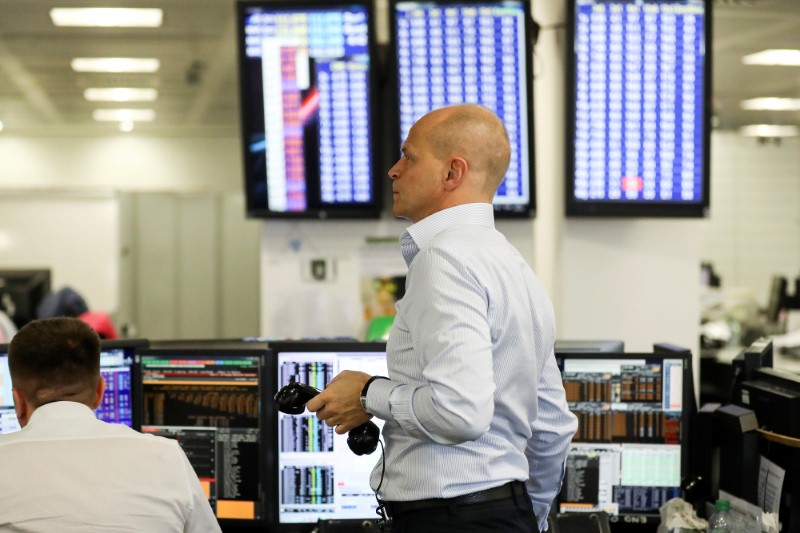Gold scales new record high; nears $4,200/oz on Fed easing bets, trade tensions
Investing.com -- U.S. stocks advanced on Friday, capping off one of the most turbulent weeks in recent memory for Wall Street.
The S&P 500 rose 1.81% to close at 5,363.36, while the Dow Jones Industrial Average added 619.05 points, or 1.56%, to finish at 40,212.71. The Nasdaq Composite gained 2.06%, ending the session at 16,724.46.
Markets pushed higher late in the day following remarks from the White House suggesting U.S. president Donald Trump is "optimistic" that China will work toward a trade agreement with the United States.
The week was one of the most volatile weeks ever on Wall Street. Markets sold off sharply on Thursday amid renewed trade concerns, just a day after a powerful rebound sparked by Trump’s announcement of a 90-day pause on some of the planned “reciprocal” tariffs.
Despite the volatility, all three major indexes ended the week with strong gains. The S&P 500 climbed 5.7%, its best weekly performance since November 2023. The Nasdaq jumped 7.3%, marking its strongest week since November 2022. The Dow advanced nearly 5% over the five-day period.
This week, investors will closely monitor U.S. economic data for signs of growth momentum.
With first-quarter GDP estimates already looking weak or potentially negative, March updates on industrial production and retail sales will be key inputs for nowcast models.
Retail figures will be particularly scrutinized for evidence of softer household spending following recent declines in consumer confidence.
According to ING economist James Knightley, retail sales “should be very strong” as consumers made big purchases before the tariffs were imposed.
“This should be enough to prevent GDP growth from contracting in the first quarter, but we still fear weakness will be renewed in the coming months,” he said.
Meanwhile, import prices and inventory data will also be monitored this week for potential impacts from tariff-related shifts.
TSMC, Netflix, Wall Street banks to report earnings
In addition to economic updates, this week also marks the first full slate of Q1 2025 earnings reports.
The reports will serve as a fresh test for markets, with several major companies set to announce results. Key names include leading Wall Street banks, Johnson & Johnson (NYSE:JNJ), Taiwan Semiconductor Manufacturing (NYSE:TSM), and Netflix (NASDAQ:NFLX).
Investors and analysts will be watching closely to see which companies voice confidence in their outlooks amid ongoing tariff uncertainty.
Other notable reports expected in the coming days include American Express (NYSE:AXP), UnitedHealth Group (NYSE:UNH), Blackstone (NYSE:BX), and Abbott Laboratories (NYSE:ABT).
What analysts are saying about U.S. stocks
Morgan Stanley (NYSE:MS): “Offsetting forces mean we’re likely in a trading range of 5000- 5500. The 90-day pause on reciprocal tariffs and further concessions over the weekend lessen the near-term probability of a recession, but uncertainty remains high, the Fed is on hold and back-end rates are a headwind.”
Citi: “We downgrade the U.S. market to Neutral (from Overweight previously). The drivers of “exceptionalism” are fading, both from a GDP and EPS perspective. Tariffs, as they stand, could negatively impact U.S. EPS the most. Even after the latest sell-off, the market remains expensive, trading at 80th percentile valuation multiple vs. history.”
JPMorgan: “As of Friday’s close, we believe recession is at best half way priced. We note that in the past 5 downturns, S&P 500 on average fell 37% peak to trough. Last 3 times, starting forward P/E was 19x, and trough P/E 12x. So far, from the February market peak to last Friday close, the S&P500 is down 13%, and currently trades on 19x P/E. These are valuation levels seen at the start of a downturn, rather than at the end.”
“Even in light of the latest 90-day tariffs pause for non-retaliating countries and the electronics exemptions, given that SPX is now only 5% below the levels held on 2nd April, we struggle to see equities trading sustainably above the pre- “Liberation Day” levels.”
Evercore ISI: “EVR ISI Strategy continues to believe Trump wishes to avoid precipitating a recession, a key reason we forecast 2025 S&P 500 at 5,600. Last week’s 90-day tariff pause highlights Trump’s desire for “winning deals”. At the same time, a significant derating in companies has happened. ~80% of stocks trading below their 5-yr average PE has occurred around market bottoms and has portended strong forward performance. A significant number of shares trading at trough valuations, and some stocks at peak valuations, could be more/less immune (respectively) into 1Q25 EPS season from ongoing elevated Uncertainty and downward S&P 500 EPS revisions.”
RBC Capital Markets: “If investors bake in a recession, we’d expect the S&P 500 to break below Tuesday’s low and approach the 4,200-4,500 range, which would represent a percentage drop in line with the median and average recession over time. But if investors can be convinced that recession fears are overblown and the trade war narrative continues to improve, some of our sentiment and valuation indicators suggest that the recent low in the S&P 500 may be able to stick, at least temporarily, even though conditions may remain choppy for a while.”
